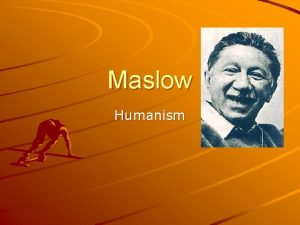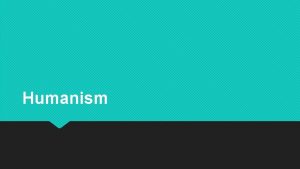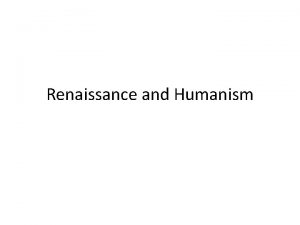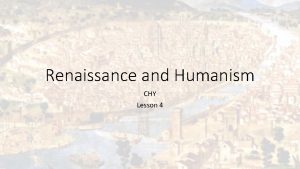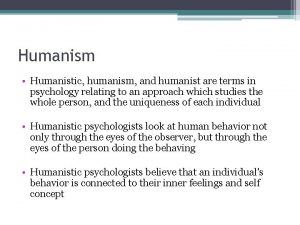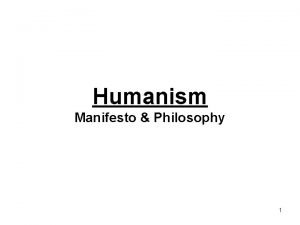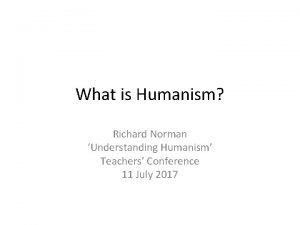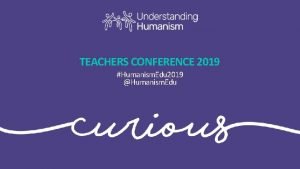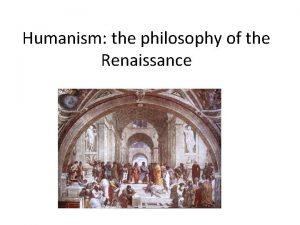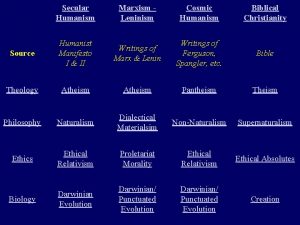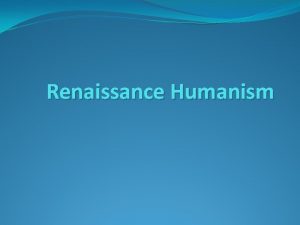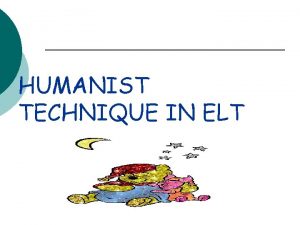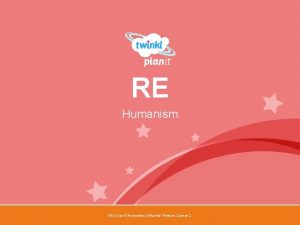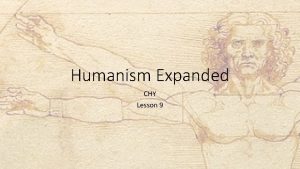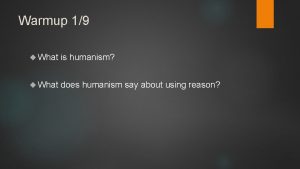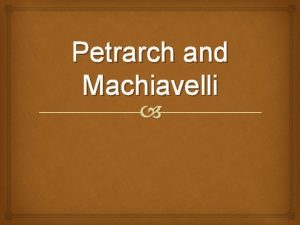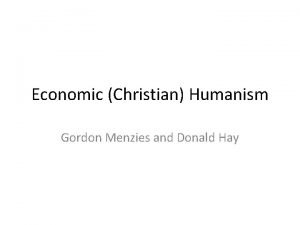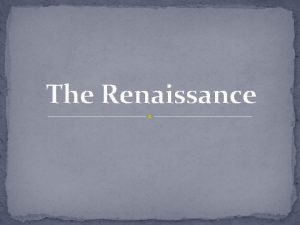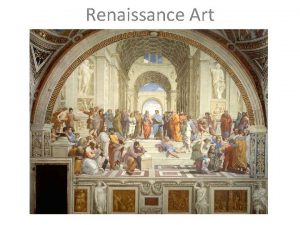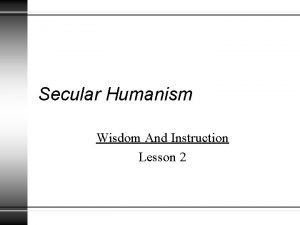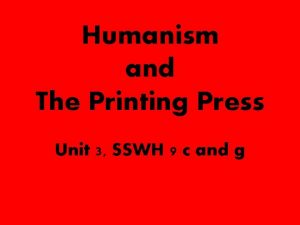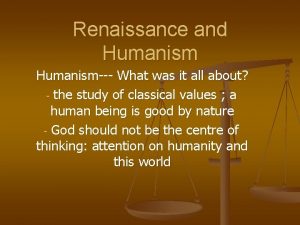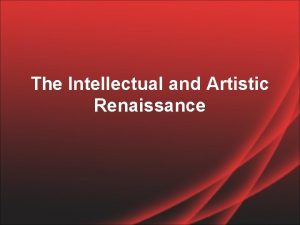Humanism Humanism In the 15 th and 16




















![Preparing for the massacre "Huns 003" by Carl Jacob Wilhelm Huhn - [1]. Licensed Preparing for the massacre "Huns 003" by Carl Jacob Wilhelm Huhn - [1]. Licensed](https://slidetodoc.com/presentation_image_h2/a4d9eeff07d665647ffa25a5e583fc10/image-21.jpg)





- Slides: 26

Humanism

Humanism • • In the 15 th and 16 th centuries, scholars known as humanists rediscovered ancient Greek and Roman philosophers. These philosophers studied the meaning of life and the role of humans in society. Statue of Plato, ancient Greek philosopher

Differences in thought Medieval thought n n n God is the central concern. The need to believe. Studying theologians’ commentaries of the Bible. Humanist thought n n n Human beings are central concern. The desire to know. Education focuses on individual learning and development.

The printing press • • • In 1450, Johannes Gutenberg invented a printing press. In 1455, the first book printed in Europe was a Bible. This invention allowed for a large circulation of books. Gutenberg’s press.

Scientific progress • • • In the Middle Ages, the Church had control over science. Humanists criticized accepted beliefs and experimented. Progress was made in medicine, math, geography, astronomy, physics, etc. Heliocentrism, or the idea that the Earth revolves around the Sun

Christianity and Protestantism

n n During the Middle Ages, the Church was powerful. The pope and bishops acted as noblemen and lived in luxury. Parish priests neglected their parishioners. Indulgences were also sold: “If you give money to the Church, you will receive an indulgence for yourself or for the soul of someone else. ”



Johann Tetzel n -selling of indulgences as a free ticket to heaven. “As soon as the coin in the coffer rings, The soul from purgatory springs!”

The Protestant Reformation: John Wicliffe n “People may read and interpret the bible for themselves. ” He translated the Latin Bible into English. Jan Hus n Was burnt at the stake for criticizing the structure and hierarchy of the Church.

Martin Luther n Rejected the authority of the Pope. n Bible is the only source of Christian faith. n Bible is the only authority. n Priests don’t have more power than lay men (people not part of the Church).

n n n 95 Theses: Document nailed to the door of the Wittenberg Cathedral in Germany. Criticizing certain practices of the Roman Catholic Church. Luther was tried and excommunicated.

John Calvin n He spread Luther’s ideas. Believed in predestination (idea that God has already decided your fate from the beginning) Believed that the faithful should lead virtuous lives based on honesty and good morals.


n n Henry VIII wanted a divorce from Catherine of Aragon. Pope Clement VII refused. Henry VIII created his own Church. Catholic Church was replaced by the Church of England - the Anglican Church.

The Counter-Reformation Series of reforms in response to Protestant criticism. Pope Paul III -------- Council of Trent n To determine the doctrine of the Church. n To clean up corruption. n To return the Church to its original purity.

1) 2) Creation of new religious orders. (Society of Jesus meant to convert non-Christians) Inquisition was brought back to combat heretics and prohibit certain books.

16 th century: Period of religious war all over Europe.

St. Bartholomew’s Day Massacre
![Preparing for the massacre Huns 003 by Carl Jacob Wilhelm Huhn 1 Licensed Preparing for the massacre "Huns 003" by Carl Jacob Wilhelm Huhn - [1]. Licensed](https://slidetodoc.com/presentation_image_h2/a4d9eeff07d665647ffa25a5e583fc10/image-21.jpg)
Preparing for the massacre "Huns 003" by Carl Jacob Wilhelm Huhn - [1]. Licensed under Public Domain via Commons -

Catherine de Medici inspects the bodies "Debat-Ponsan-matin-Louvre" by Édouard Debat-Ponsan - Mairie de Clermont. Ferrandhttp: //www. clermont-ferrand. fr/. Licensed under Public Domain via Commons - https: //commons. wikimedia. org/wiki/File: Debat-Ponsan-matin-

Pope Gregory XIII orders medal to commemorate massacre "Gregory XIII medal" by ordered by pope Gregory XIII http: //www. aloha. net/~mikesch/dragon. htm. Licensed under Public Domain via Commons https: //commons. wikimedia. org/wiki/File: Gregory_XIII_medal. jpg#/media/File:

Religious and political issues are at stake. Henry the IV of France Edict of Nantes 1598 n n Basic rights of Protestants are protected, ending the religious warfare.

Review Questions 1. 2. 3. 4. 5. When did the Renaissance begin? Where did it begin and why? What is humanism? What changed with the arts? What changed with science?

n 6. Why did people criticize the Church? n 7. What protestant religions were founded? n 8. What was different between the Catholic Church and the Protestant religions?
 Maslow and humanism
Maslow and humanism Hình ảnh bộ gõ cơ thể búng tay
Hình ảnh bộ gõ cơ thể búng tay Lp html
Lp html Bổ thể
Bổ thể Tỉ lệ cơ thể trẻ em
Tỉ lệ cơ thể trẻ em Voi kéo gỗ như thế nào
Voi kéo gỗ như thế nào Glasgow thang điểm
Glasgow thang điểm Hát lên người ơi alleluia
Hát lên người ơi alleluia Môn thể thao bắt đầu bằng chữ đua
Môn thể thao bắt đầu bằng chữ đua Thế nào là hệ số cao nhất
Thế nào là hệ số cao nhất Các châu lục và đại dương trên thế giới
Các châu lục và đại dương trên thế giới Công của trọng lực
Công của trọng lực Trời xanh đây là của chúng ta thể thơ
Trời xanh đây là của chúng ta thể thơ Cách giải mật thư tọa độ
Cách giải mật thư tọa độ Làm thế nào để 102-1=99
Làm thế nào để 102-1=99 độ dài liên kết
độ dài liên kết Các châu lục và đại dương trên thế giới
Các châu lục và đại dương trên thế giới Thơ thất ngôn tứ tuyệt đường luật
Thơ thất ngôn tứ tuyệt đường luật Quá trình desamine hóa có thể tạo ra
Quá trình desamine hóa có thể tạo ra Một số thể thơ truyền thống
Một số thể thơ truyền thống Cái miệng nó xinh thế
Cái miệng nó xinh thế Vẽ hình chiếu vuông góc của vật thể sau
Vẽ hình chiếu vuông góc của vật thể sau Thế nào là sự mỏi cơ
Thế nào là sự mỏi cơ đặc điểm cơ thể của người tối cổ
đặc điểm cơ thể của người tối cổ Ví dụ về giọng cùng tên
Ví dụ về giọng cùng tên Vẽ hình chiếu đứng bằng cạnh của vật thể
Vẽ hình chiếu đứng bằng cạnh của vật thể Fecboak
Fecboak
